Jackery Explorer 2000 Pro review: Lots of emergency power, but is it truly portable?
When Jackery approached me and asked if I would like to look at their new $6,200 six-panel, 2200W portable solar generator, I admit that I had some selfish motives in mind.
Over the past few years, I planned to go off the grid and put solar panels on my roof, which would also act as backup power during a large-scale infrastructure failure, such as one that a major hurricane would cause.
But the rising costs of a residential solar buildout due to supply chain issues during the pandemic and the uncertain future of Florida’s net metering situation (which was only recently resolved), plus the need for a total roof replacement caused me to cancel my plans to spend over $100,000 on a new solar roof, batteries, and electrical upgrades.
$6,200 is a lot less than $100,000, especially if I’m talking about a product that I would mainly be using during an emergency. The question is, how well does it work?
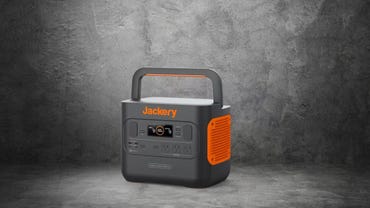
Like
- Lots of power for campers and emergency use
- Plenty of power ports
- Compact for storage
Don’t Like
- Multi-panel setup can be complicated
- System isn’t waterproof
- Six panel system weighs 150lbs
The tech
The Explorer 2000 Pro is eighth in the line of portable solar power generator products released by the company and is also its most powerful, with a total power generation capacity of 2200W (2.2 kWh). The kit sent to us as configured comprises six (6) 200W 18V solar panels, supplying 1200W peak power to the generator.
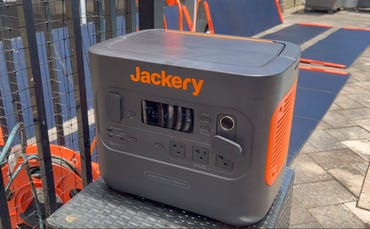
A front view of the generator panel.
Jason Perlow/ZDNet
The generator itself, which resembles a UPS battery backup unit (and essentially is, with modifications), has 2160W of battery storage, three sinewave 120V AC ports, dual USB-PD 100W ports, and a single 12V carport.
Each 18.3 lb SolarSaga 200W panel is about 7’7″ long by 2′ high when unfolded from its ballistic fabric carrying case. It comprises four-panel segments, which fold into a square measuring 2′ x 2′ and 2″ thick.
The generator itself weighs 43 lbs and has a large carrying handle. It has a color LED display that indicates the current level of charge for the generator/battery, the current wattage input from the panel array, and the current output.
Setting it up (and tearing it down)
The use case scenario for all of the Jackery products to date has been for outdoors and camping, in which the entire setup can be unpacked and set up in a matter of minutes. Typically, these are one or two-panel scenarios for its SolarSaga 60 and SolarSaga 100 products, which are ⅓ to ½ the size and weight of each SolarSaga 200 foldable panel. The Explorer 240, 500, 1000, and 1500 generators are also considerably smaller (and lighter) than this product is.
Jackery maintains that camping and outdoor activities are still the prime use case for the product. However, while the SolarSaga 200W panels are IP67 rated for water immersion or resistance, the company does not recommend their use in the rain because water can damage their connection ports.
Of course, this is easily solvable by wrapping the connection ports and cable connectors in good ‘ol duct tape, which I ended up doing. But the company could have easily designed or licensed/sourced a connector hood on the panel (and the generator) that encloses the cable and a connector that seals out the elements. Why Jackery bothered with an IP67 rating for the panels and did not do this for the cables and connectors, I do not know.
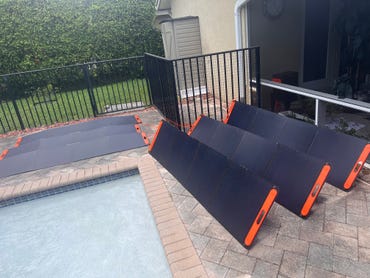
Good luck getting around that swimming pool!
Jason Perlow/ZDNet
The generator is not guaranteed to be waterproof — although my test unit did get rained on several times, and nothing happened to it. The company recommends that in the event of rain, the generator be retrieved and put indoors and that the panels also are retrieved.
This presents some interesting use case issues and challenges for the Explorer 2000 Pro. While the setup is “portable,” all the components’ combined weight is over 150 lbs. For a single person to do setup or takedown, this is easily a 30-minute procedure, involving the unpacking of each panel from its fabric carrying case, placing it on the ground or propping it up on its integrated stands, and connecting it with a cable home ran to a splitter dongle that is connected to the generator which can accommodate two dongles total.
The generator performs the DC to AC inversion internally, as the panels do not require separate inverters as residential and commercial panels have for fixed configuration setups.
The panels cannot be connected in a “serial” fashion. There is only one connection port per panel on the upper left (in a sun-facing position). Each panel has a 10′ 18V DC power cable, which connects directly to the 2′ splitter/dongle, which can accommodate up to three cable connections.
Setup is a cumbersome process as sufficient space needs to be available for panel placement and cable layout, especially if the generator is to be removed from the elements.
The system requires panel input to be fully load-balanced — if you want to run in sub-capacity, with less than the full six-panel configuration, then you can run one panel (direct), two panels (direct), three panels connected via one dongle, or four panels (two dongles, with one connection on each dongle capped).
For a single or dual-panel config for one of the previous generation products, or even this product, it’s no big deal. However, for a six-panel deployment, with over 150 lbs worth of equipment, setup and panel placement is not a trivial activity. I eventually placed the panels on my pool deck, in an L-shaped configuration, with the cables coming into my back patio doggie door and the generator propped up under cover in the patio, away from the rain.
It took about 40 minutes to achieve the best working setup with the most efficient cabling the second time around.
This is the most likely and most useful scenario for how I would deploy this at home after a post-hurricane infrastructure failure. I contemplated how I might place the panels on my front lawn and the generator on my front foyer undercover, with extension cords leading into the house, but it was not workable.
Realistically speaking, I don’t see how in environments where this might be used for emergency power, or even in a camping scenario, how the average person is going to rush outside and disassemble 109 lbs worth of solar panels and cables and drag them inside in the event of a sudden rainstorm.
States like Florida, Georgia, Texas, Louisiana, Mississippi, and the Carolinas are the perfect use cases for a large emergency solar generator like this. All of these are hot weather states and would need a higher generation capacity to power small refrigerators, fans, and other cooling appliances. All of these are also subject to sudden capricious weather when they would need the solar panels in the first place, particularly during the immediate aftermath of a major storm.
Using the generator
That being said, I feel that this product can do a fantastic job when needed. It employs a proprietary battery conditioning system and dual power management chipset to keep its lithium-ion battery packs healthy and fresh, like those seen on EVs. When the generator unit arrived, it only had about a 20 percent charge on the battery, and I let it continue to charge for the next two days via the panels as devices were plugged into it. However, in a pre-storm situation, the generator and other battery-powered components in my household would be charged directly via AC power to provide enough buffer for continuous power draw. In fact, the company does suggest that the generator’s charge be topped off at least every three months to maintain battery life.
To test the generator, I used a variety of household appliances to see how much continuous power I would get, including a small commercial refrigerator, a small 15L refrigerator for car/12V use, various fans, and a portable induction burner cooktop.
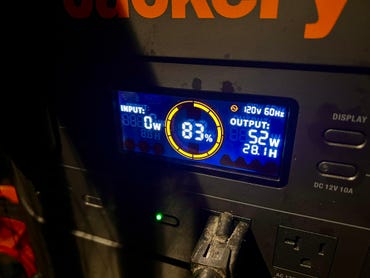
As there’s no sun at night, you just consume energy from the generator battery.
Jason Perlow/ZDNet
While the system has a maximum 1200W input capacity from the six 200W panels and a possible 2.5-hour recharge rate, that is a best-case scenario. During the week in early May of 2022, when I tested it in South Florida, where I had intermittent rain, I had partly sunny skies at best. So I saw a fluctuating range of energy generation between 200W and 900W at any given time, and I never saw peak performance from the panels, which is realistic.
However, that is more than sufficient power to recharge the 2200W battery over the day completely. The 15L AstroAI refrigerator/freezer,which I hooked up, draws about 60W to run the compressor for several hours to get it to cooling level and only 3W-16W of power to maintain 34-degree temperatures. The generator estimated about 30-50 hours of use on that one appliance while it was plugged in, assuming no power regeneration.
Similarly, with the Vornado fans I also saw about 60W at peak (high) use, so I could easily have a few of these hooked up via extension cords and surge suppressor units to expand the three AC ports on the generator, and have the power to spare through the next morning if I used them all day before it restarted the recharge cycle. LED lamps such as my Philips bulbs also did not have that much power draw; I only saw between 6W and 13.5W of power draw per bulb total depending on the dim level.
I saw extreme power draw from cooking appliances, such as the portable induction burner that I used for my cooking demonstration in the review video. At 100 percent power (stockpot water boiling level), the Duxtop draws over 1700W, which would fully deplete the generator in perhaps 75 minutes of use. But I only needed to use it for about 10 minutes to cook breakfast and never ran it more than 50 percent power.
While induction burners are highly efficient appliances, as they directly conduct energy to the pan, and do not consume much power at all when the pan is not conducting to the burner (about 5W total when in standby mode), I probably would not choose to use this method for cooking food in an emergency scenario. Most likely, I would be using propane gas and a side burner on one of my BBQ grills, or perhaps I might investigate solar cooking, such as one of the GOSUN units. But it’s good to know that a green and renewable solution like this works, should propane or natural gas become increasingly scarce.
Small air conditioners, such as 12,000 BTU/1000W mini-splits, seem out of the question, as you could maybe get two hours of use. I also didn’t bother trying to plug in my 120V Level 1 charger that came with my Polestar 2 that I recently purchased — I know from experience that would only give us about 1 mile per hour recharge rates. To get higher than that, I’d need my Level 2 — which requires a 240V 50A connection.
Perhaps with the Jackery Explorer 4800 Pro, which has twelve 400W panels and comes out in 2030… Just kidding.
When the generator hits 100% charge, the input power from the panels registers as zero watts — and it did this for as long as 30 minutes when devices were connected to the generator and consuming power. I don’t know if this is a software bug or if the system is designed such that the panels do not supply energy until the generator dips below a certain level, such as 90%. Still, I wonder if there is sufficient surplus energy; perhaps it should be used to charge another large battery or portable power station to capture it for use with other smaller appliances.
What I would like to see improved
In addition to the water-resistance/waterproofing concerns I addressed earlier and the lack of cable serialization that prevents more flexible panel placement, I would like to see more diagnostics capabilities in the main display.
Specifically, I’d like more details about individual panel performance on a large system such as this. Currently, from the generator itself, there is no way to tell if any single panel is or isn’t supplying energy. Instead, what you get on the display is an aggregate calculation of wattage across the entire array.
In an ideal scenario, at full sunlight, with no atmospheric obstructions or diffusion, and with clear skies, one might get over 1000W of aggregate power generation, but that’s not realistic. So at any given time, with clouds passing overhead and interfering with the sun, you’ll see fluctuating totals nowhere near the peak system capacity.
The display can only tell you if the array supplies power, period, and wattage. For debugging purposes, it would be nice to know which panel is supplying what; otherwise, it becomes a round-robin plug-and-play process to ensure each panel is functioning. Alternatively, the dongles could implement an indicator (such as a tiny e-ink display or LED) that shows power coming from each input.
An app that helps the user calculate energy consumption and plan for plugged-in device usage would benefit a system of this size. Naturally, this would require some communication mechanism that the product does not currently have. This could be implemented via Bluetooth Low Energy, as the data transfer speeds do not need to be high for simple telemetry functions from the generator and panels. Such a component would have minimal system cost and power consumption impact.
Ideally, with such an app, I’d like to see a way to record each device that gets plugged in, what their approximate consumption is, and how many hours/minutes the generator has left as it happens. This would be particularly useful at night when the panels cannot recharge the generator, and priorities need to be made. It would also be helpful if notifications were sent if large consumption spikes occur and how it impacts the remaining battery and expected charge.
Conclusion
Despite its shortcomings and setup complexity, I think the Jackery Explorer Pro 2000 could be beneficial to many folks who live in areas that are at risk of infrastructure failure. This product can power many appliances for more extended periods than less capable portable solar power generation systems.
But I do not think this is a “camping” or “outdoorsman” product unless we are talking about UN field deployments in the hottest and driest parts of Africa (and I would suggest they keep the generator itself in the shade, as it’s only rated to 149 degrees F) or extreme explorers in the 24/7 sunlight in the summer months in the arctic circle. For campers that don’t need such heavy power generation requirements, and for a simpler single or dual-panel setup, I’d recommend the Jackery Explorer 1500, the Jackery Explorer 1000, or buying an Explorer Pro 2000 with only two panels, which would theoretically charge the generator in under eight hours.

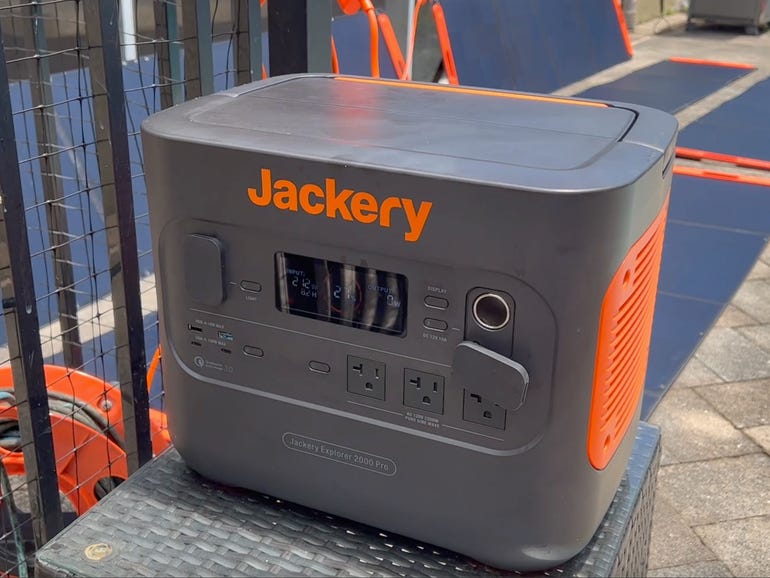


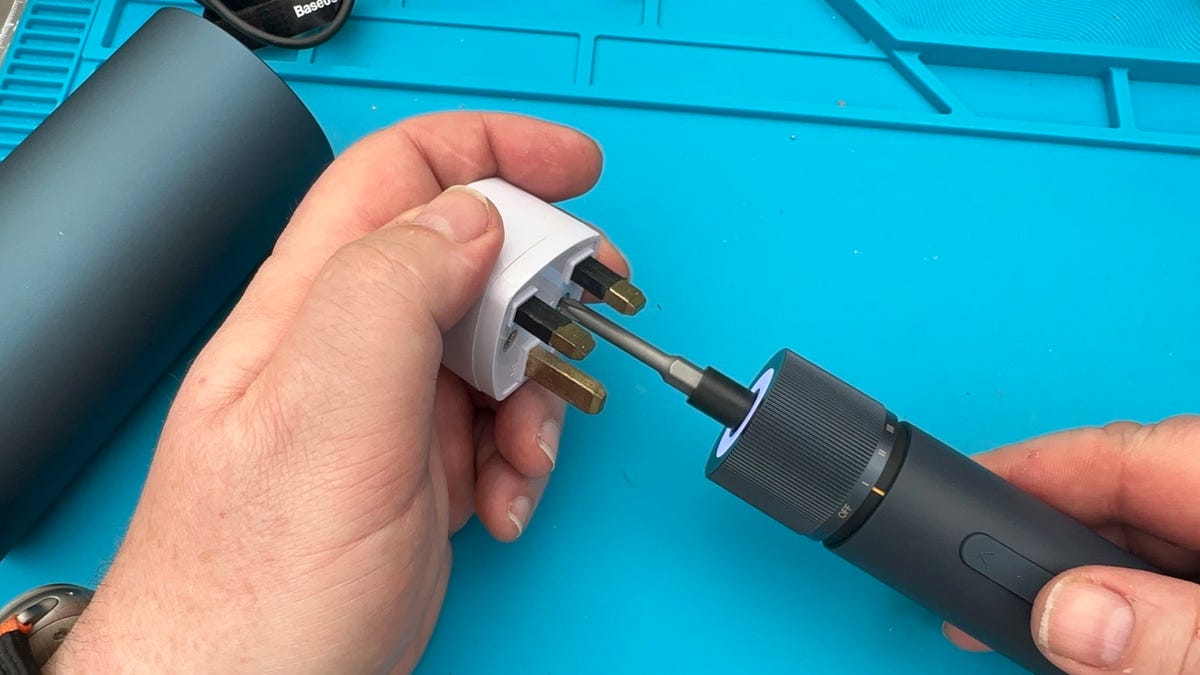
Pingback: h k usa
Pingback: บอลยูโร 2024